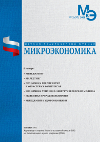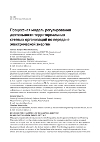Business process model of regulating electric power distribution tariff-setting
DOI: 10.33917/mic-2.97.2021.64-74
The paper proposes a business process model of regulating electric power distribution tariff-setting. The model differs from the existing today model in that the regulatory decision-making process is carried out straight from the top down without intersection of information flows. At first key regulation indicators are set at macroeconomic level. These indicators support the achievement of Sustainable Development Goals adopted by the United Nations in 2015. Then the key regulation indicators are distributed among the subjects of the Russian Federation based on empirical dependencies. At the lowest level the actual performance indicators received from independent automated state information systems are compared with the key regulation indicators. Such a model has got a clear structure, allows to increase the objectivity and reduce the resource intensity of regulatory decision-making.
References:
1. Joskow P.L. Chapter 16 Regulation of Natural Monopoly // Handbook of Law and Economics. 2007. Vol. 2. pp. 1227-1348. – doi: 10.1016/S1574-0730(07)02016-6.
2. Korolev I.A. Models and methods for analyzing the impact of electricity pricing on the macroeconomic indicators of economic sectors: abstract of the dissertation of the Candidate of Economic Sciences: 08.00.05. St. Petersburg, 2014. 19 p.
3. Pigou A. Economic theory of welfare, vol. 1. Per. s engl. M.: «Progress», 1985. 512 p.
4. Durand E.D. The Trust Problem // The Quarterly Journal of Economics. 1914. Vol. 28, No. 4 (Aug., 1914). pp. 664-700. [Electronic resource]. – Access mode: https://www.jstor.org/stable/pdf/1885650.pdf. (date accessed: 09.01.2020).
5. Korolkova E.I. Trends in the development of theoretical approaches to the regulation of natural monopolies // Economic Journal of the Higher School of Economics. 1999. T. 3, No. 2. pp. 238-264.
6. Demsetz H. Why Regulate Utilities? // The Journal of Law & Economics. 1968. Vol. 11. № 1. pp. 55–65.
7. DiLorenzo Th. The myth of natural monopoly // The Review of Austrian Economics. 1996. Vol. 9. No. 2. pp. 43-58.
8. Svirina L.N. On the introduction of the process approach in the sphere of public administration // Bulletin of the Institute of Economics of the Russian Academy of Sciences. 2019. No. 3. pp. 83-91. – doi: 10.24411/2073-6487-2019-10033.
9. Improving the system of public administration in the Republic of Kazakhstan / S.M. Omirbayev, D.M. Nurkhalieva, L.Z. Beisenova // Agriculture-problems and prospects: Collection of scientific papers. Grodno: Grodno State Agrarian University, 2017. pp. 228-236.
10. Vasilyeva M.N., Kalinina O.V. Modern aspects of the development of management technologies in the public sector on the basis of the process approach / / Fundamental and applied research in the field of management, economics and trade: collection of proceedings of the scientific and educational-practical conference: in 3 parts. St. Petersburg: Peter the Great St. Petersburg Polytechnic University, 2017. pp. 40-46.
11. Kovalchuk L.B. Application of the process approach in the management of the regional socio-economic system / / Izvestiya Irkutsk State Economic Academy (Baikal State University of Economics and Law). 2015. Vol. 6. No. 2. pp. 142-150 – doi: 10.17150/2072-0904.2015.6(2).12.
12. Malafeevsky T.A. Process approach as a basis for the implementation of quality management in public administration // Science and innovation in technical universities: materials of the Thirteenth All-Russian Forum of Students, Postgraduates and Young Scientists. St. Petersburg: Peter the Great St. Petersburg Polytechnic University, 2019. pp. 134-136.
13. Fedulova E.A. Process approach as a basis for the formation of the system of public management of territories / / Bulletin of the Research Center of Corporate Law, Management and Venture Investment of Syktyvkar State University. 2014. No. 3. pp. 142-151.
14. Hammer M., Champi J. Reengineering of the corporation: Manifesto of the Revolution in Business. Trans. from English. St. Petersburg: St. Petersburg University Press, 1997. 332 p. – ISBN 5-288-01978-9.
15. Sustainable Development Goals [Electronic resource]. – Access mode: https://www.un.org/sustainabledevelopment/ru/sustainable-development-goals/ (date accessed: 19.11.2020).
16. Mark D.A., McGowan K. Methodology of structural analysis and design of SADT. [Electronic resource]. – Access mode: https://pqm-online.com/assets/files/lib/books/marka.pdf. (date accessed 17.01.2021).
17. Decree of the Government of the Russian Federation No. 1178 of 29.12.2011 «On pricing in the field of regulated prices (tariffs) in the electric power industry». – Access from the ConsultantPlus legal reference system.
18. Mishura A.V. Assessment of the elasticity of demand for electricity from the population in Russia.Vestnik NSU. Series: Socio-economic sciences. 2011. Volume 11. Issue 2. pp. 92-101.
19. Mishura A.V. Long-term elasticity of demand for electricity from industrial consumers in Russia. Vestnik NSU. Series: Socio-economic sciences. 2008. Volume 8. Issue 3. pp. 14-24.
20. Sharova A.Yu. Dynamics of changes in the location of countries on the energy-demographic diagram of the world // Transport Business of Russia. 2013. No. 6-2. pp. 51-54.
21. Klimenko V.V., Tereshin A.G. World energy and global climate in the XXI century in the context of historical trends: Limits of growth // Universal and global history. Evolution of the Universe, Earth, life, society / Edited by L.E. Grinin, I.V. Ilyin, and A.V. Korotaev. Volgograd: Uchitel, 2012. 688 p. (Library of the Faculty of Global Processes of Moscow State University). – ISBN 978-5-7057-3237-1.
22. Federal Law No. 522-FZ of 27.12.2018 «On Amendments to Certain Legislative Acts of the Russian Federation in connection with the Development of Electric Energy (Capacity) Metering Systems in the Russian Federation». – Access from the ConsultantPlus legal reference system.



